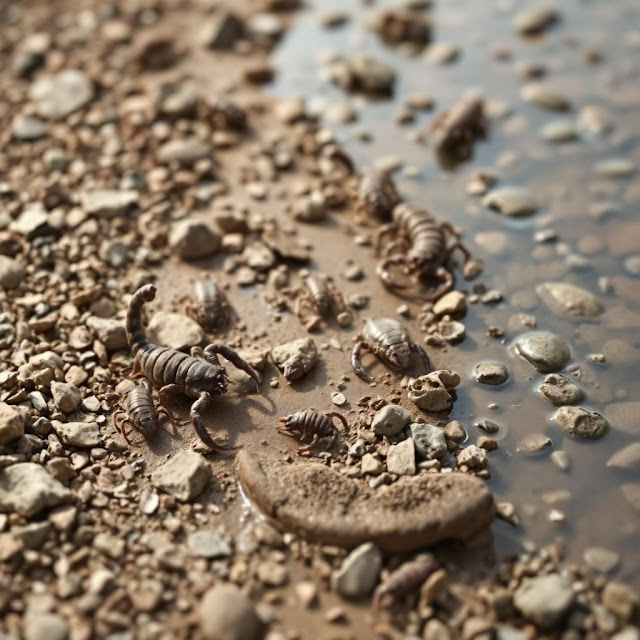The First Pioneers of Land: How Ancient Scorpions Stepped Ashore
INTRO:
Do know When the average human being talk or think about the earliest life on Earth, images of primordial oceans teeming with ancient marine creatures come to mind as a result of what we have learned from our school days from elementary school to University. The transition from water to land is one of the most significant milestones in evolutionary history. And in this tale of transformation, scorpions hold a pivotal role. These ancient arachnids may have been some of the first animals to make the brave journey from water to solid ground, according to fossil experts. Let’s explore what this discovery means and how it reshapes our understanding of early terrestrial life.
Outlines:
- Ancient Scorpions: The First Land Adventurers
- The Fossil Evidence and Its Significance
- A Life Between Land and Water
- Rewriting the Evolutionary Timeline
- The Impact of a Landward Journey
- Conclusion
Ancient Scorpions: The First Land Adventurers:
Fossil evidence has often painted a picture of scorpions as trailblazers, among the earliest creatures to venture from aquatic realms to a terrestrial existence. The recent discovery of two new fossilized scorpions adds weight to this fascinating theory and ignites ongoing debates about when animals first made the leap to land. These fossils were unearthed in Wisconsin in the 1980s, at a site near a quarry north of State Highway 164. The specimens are estimated to be around 437 million years old and measure approximately 2.5 centimeters in length. While scientists agree that these fossils date back to a crucial time in Earth’s history, the discussion continues about whether these scorpions truly left the water behind.
The Fossil Evidence and Its Significance:
The scorpions in question belong to a species named Parioscorpio venator, a name that translates to “ancestral scorpion hunter.” In appearance, these ancient creatures resembled modern-day scorpions, boasting two prominent claws and a stinger-tipped tail. The true marvel, however, lies not in their appearance but in their internal anatomy, which has offered fresh insights into the evolutionary journey from sea to land. Dr. Andrew J. Wendruff, a paleontologist at Otterbein University in Ohio and co-author of the research, has emphasized the importance of the fossil's internal structure. “He said, "That scorpion like this had the respiratory structures that show it could live on land." These structures, along with cardiovascular features similar to those of modern scorpions, suggest that Parioscorpio venator had the ability to breathe air. This finding marks the earliest known evidence of an animal equipped for life on land.
A Life Between Land and Water:
Despite these groundbreaking insights, scientists still grapple with the question of whether these scorpions truly inhabited land or just ventured onto it sporadically. Dr. Wendruff noted that the fossils were found in what would have been a shallow aquatic environment, implying that the scorpions may have thrived in both habitats. This duality in lifestyle is not unheard of. Modern horseshoe crabs, for example, live predominantly in shallow coastal waters but can temporarily make their way onto land. “Throughout all of Earth’s history, there is a race to utilize resources that are not being used,” Wendruff remarked. “Land—something we take majorly for granted—was barren by today's standards.” The shift to land would have opened up untapped resources, offering a world of new opportunities to pioneering creatures.
Rewriting the Evolutionary Timeline:
The discovery of Parioscorpio venator challenges previous records of the earliest scorpions by pushing back the timeline by nearly three million years. Until now, the oldest known scorpion fossil was unearthed in the Pentland Hills of Scotland and was described by a Victorian paleontologist. This new find, published in Scientific Reports, raises important questions about the origins of terrestrial life. Dr. Jesús Lozano-Fernández, a palaeobiologist at the Institute of Evolutionary Biology in Barcelona, noted the ongoing debate surrounding the aquatic or terrestrial nature of early scorpions. “If the described fossil scorpion was indeed terrestrial,” he explained, “that would suggest that other arachnids with similar breathing apparatus, such as spiders, had also made the transition to land by that time.” Such a realization could mean that the entire arachnid lineage was already exploring terrestrial habitats much earlier than previously thought.
The Impact of a Landward Journey:
Understanding the move from sea to land is more than an academic exercise—it provides a window into the adaptability and resilience of life. The barren landscapes of the ancient world were ripe for colonization, and the adaptations seen in early scorpions exemplify the evolutionary drive to explore and conquer new environments. The ability to breathe air and survive on land paved the way for the future of animal life on Earth, leading to the diverse ecosystems we see today.
Conclusion:
The discovery of Parioscorpio venator serves as a reminder of the monumental shifts in life’s journey. While debates continue about the extent of their terrestrial adventures, these ancient scorpions undeniably played a key role in the story of life’s conquest of land. Each fossil unearthed not only tells a story but also brings us closer to understanding the complexities of our planet’s evolutionary past. As paleontologists continue to dig deeper, who knows what further secrets these early pioneers might reveal?






nice one
ReplyDelete